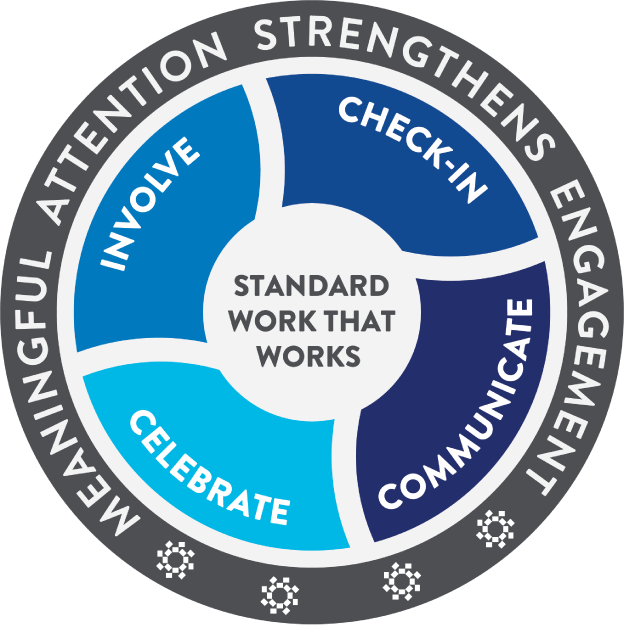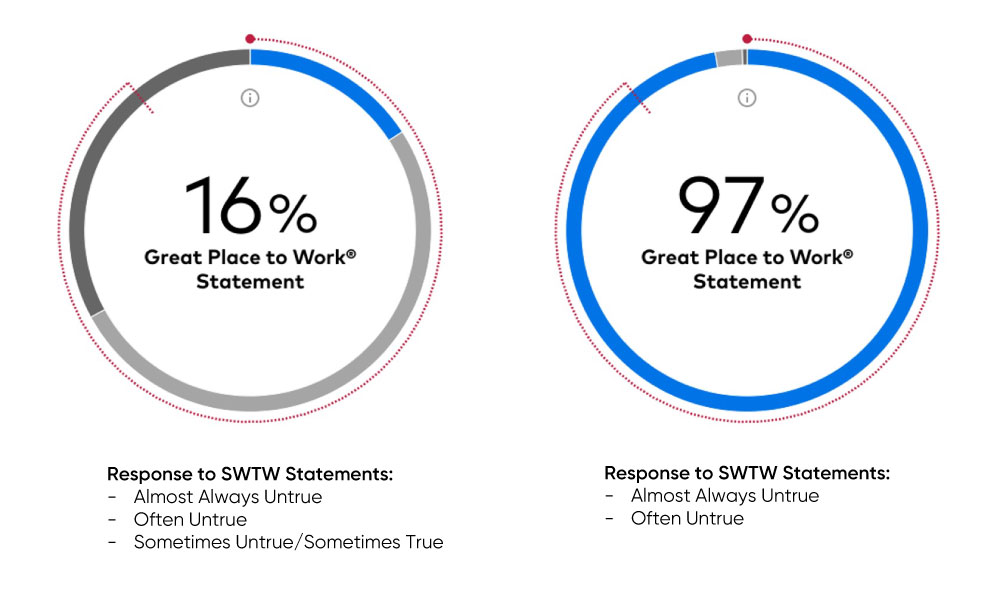Why HMH partners with Great Place To Work
The health care industry is a challenging one. Long hours, high emotions, and hazardous conditions can quickly lead to burnout if employees don’t feel they’re physically and psychologically safe.
Like at many workplaces, the culture team at HMH initially assumed that the responsibility of employee engagement fell solely on their shoulders. However, once they began digging into their Trust Index data, they quickly realized that culture is a collective effort, with clear parallels between high engagement and leaders’ actions.
“What we saw really spoke to the fact that engagement is built leader by leader, team by team,” says Tria Deibert, SVP of culture and team member well-being at HMH.
That data is now the basis of their “Standard Work that Works” model, a four-point framework for leaders to ensure a positive employee experience.
Challenge
Finding focus and setting clear goals
One of the problems with measuring employee engagement is that it’s impacted by many factors — and not all of them are in a manager’s control. Home life, personal health, and wider business issues can all impact an employee’s experience and are beyond their manager’s influence.
This posed a challenge for people managers at HMH, who had outcome-focused goals around engagement. For example, one of the survey statements, “People here quickly adapt to changes needed for our organization’s success,” is something that’s difficult for HMH’s leaders to have an impact on.
Not only that, but large data sets can be overwhelming. HMH’s leaders were stuck, struggling to align a large amount of data, some of which they couldn’t control, with a complex outcome as their goal.
“As the saying goes, when you focus on everything, you focus on nothing,” says Mary Baszkowski, director of culture and team member experience at Hackensack Meridian Health.
Solution
Correlational analysis between Trust Index scores and business success
HMH realized that leaders need clarity to effectively nurture engagement. HMH developed an engagement model, providing a clear path for leaders to support their employees with clear and actionable insights.
To achieve this, the company created a custom focus area in their Trust Index Survey, looking at four factors that are within leaders’ sphere of influence: communication, involvement, celebration, and checking in.
Statements included a mix of customized and pre-set options, such as:
- “My team consistently meets for Team Huddle at our agreed-upon time.”
- “My direct manager involves people in decisions that affect their job or work environment.”
- “Everyone has an opportunity to get special recognition.”
HMH found that employees who responded positively to all of the above statements were up to six times more likely to say HMH was a great place to work. In fact, among teams where the majority of members answered “almost always true” or “often true” to those statements, 97% said HMH was a great place to work.
In contrast, teams with mostly negative responses to those same statements — such as “sometimes true” or “untrue”— had Great Place To Work scores in the mid-teens.
The data was clear: If HMH wanted to improve company culture, they needed to start with what was in leaders’ direct control. This realization formed the basis of HMH’s “Standard Work that Works,” a culture model that aligns leadership goals with those statements.
This gave leaders clearer direction and made employee engagement a more tangible goal.
“Once we made the shift from focusing on the outcome to the actions, that was key,” says Tria.


Outcome
Better recruitment and retention, and data that tells a story
Over two years, HMH was able to drastically reduce its voluntary turnover rate, dropping it to less than 10%. Not only that, but the company has had a 13% increase in external starts and internally promoted more than 1,800 team members.
For an industry known for high burnout and turnover, these numbers were a clear indicator that their approach was the right one.
In the surveys, HMH was able to see a clear correlation between their grouped Standard Work that Works statements and their overall Trust Index statement of “This is a great place to work”:
- In 2021, 73% of responses to HMH’s Standard Work that Works focus area statements were positive, closely mirroring the 70% of positive responses to “This is a great place to work.”
- In 2024, positive responses to HMH’s Standard Work that Works focus area statements climbed to 84%, and positive responses to their “This is a great place to work” statement reached 85%.
“These position trends are not accidental,” says Mary. “They’re really a direct result of our data-driven strategy aligned with our brand values, including investments like leadership development.”

The clearer data also enabled HMH to use storytelling to get buy-in across the organization. They now had a visible cause and effect that related directly back to HMH’s mission to transform health care and be a leader of positive change.
HMH admits that it took a while to get it right. There were nine years of steady effort to finally land on the Fortune 100 Best Companies to Work For. But the numbers proved that the work was worth it.










